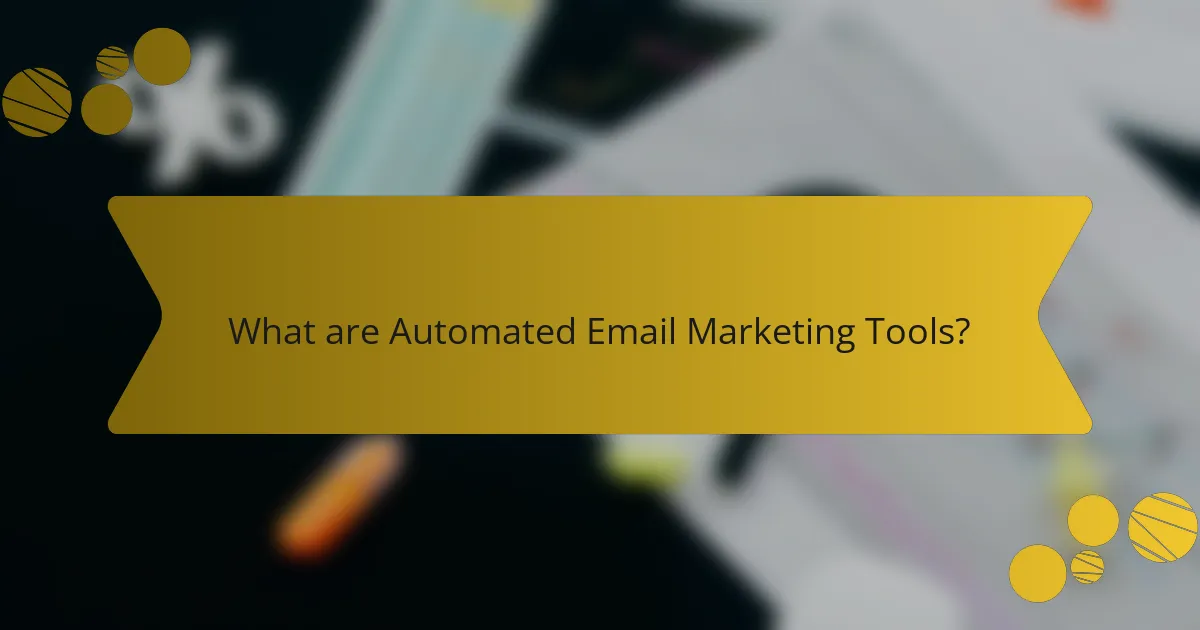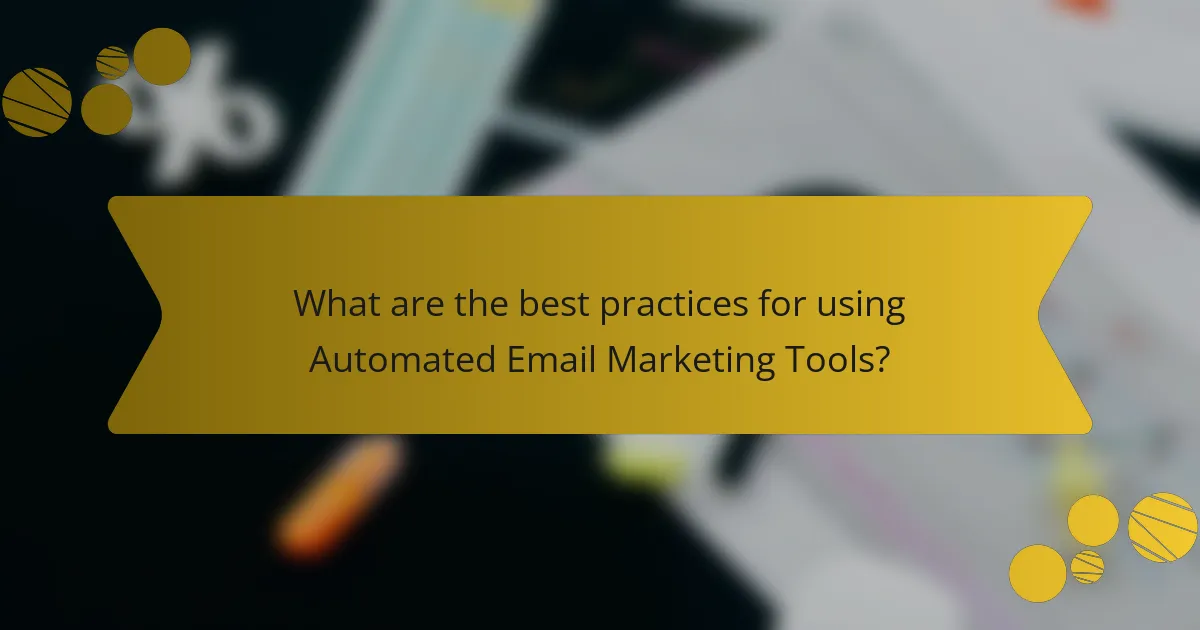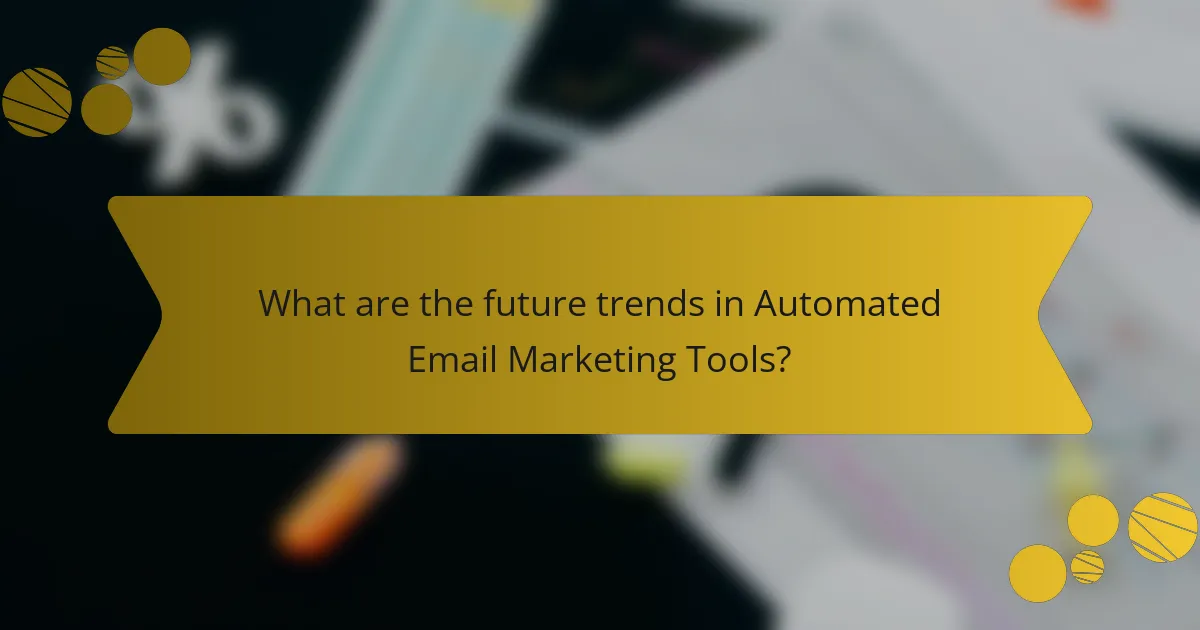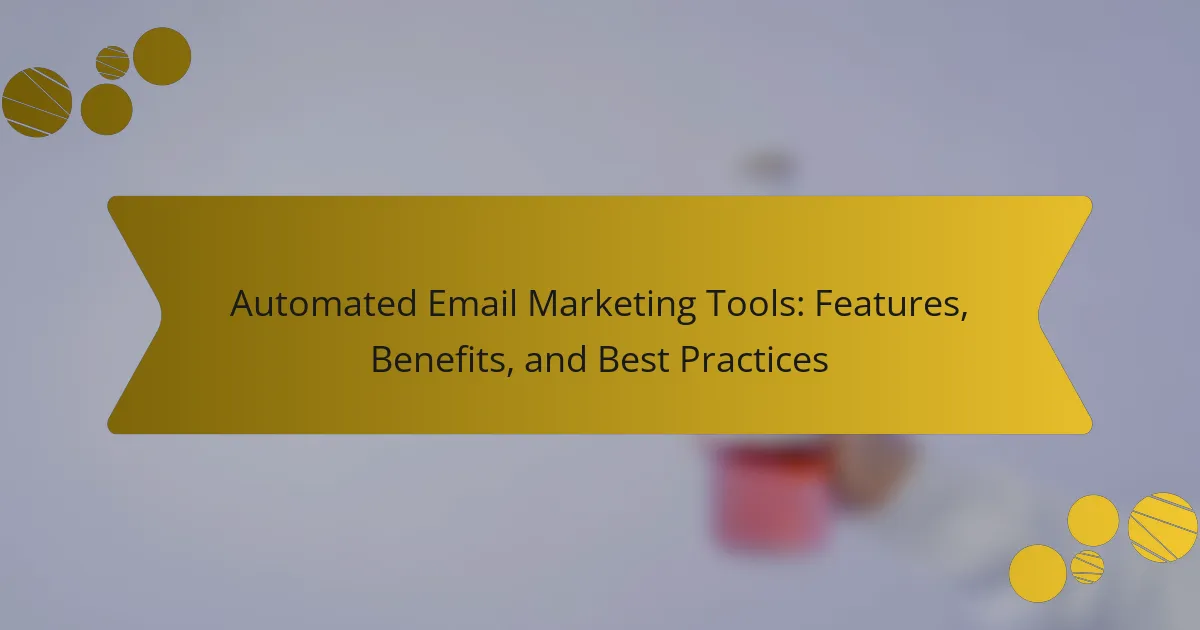Automated email marketing tools are software applications that streamline the process of sending marketing emails, allowing businesses to efficiently schedule, personalize, and track campaigns. These tools facilitate audience segmentation based on behavior or demographics, significantly enhancing engagement rates. Key benefits include increased revenue generation—automated emails can yield 320% more revenue than non-automated ones—and improved open rates through personalization. The article also explores best practices such as optimal scheduling, performance monitoring, and compliance with regulations like GDPR and CAN-SPAM. Additionally, it discusses future trends, including AI-driven content generation and enhanced segmentation, which will further optimize marketing strategies.

What are Automated Email Marketing Tools?
Automated email marketing tools are software applications designed to automate the process of sending marketing emails. These tools enable businesses to schedule, personalize, and track email campaigns efficiently. They can segment audiences based on behavior or demographics. Automation reduces manual effort and increases consistency in communication. According to a report by Campaign Monitor, automated emails can generate 320% more revenue than non-automated emails. This statistic highlights the effectiveness of these tools in driving sales and engagement.
How do Automated Email Marketing Tools function?
Automated email marketing tools function by utilizing software to send emails automatically based on predefined triggers. These triggers can include user actions, such as signing up for a newsletter or making a purchase. The tools allow marketers to create email campaigns that are scheduled to send at specific times or in response to specific behaviors.
These systems often include features like audience segmentation, which helps tailor messages to specific groups. They also provide analytics to track open rates and engagement. This data allows marketers to refine their strategies for better performance.
According to a report by HubSpot, automated emails have a 70.5% higher open rate compared to traditional emails. This statistic underscores the effectiveness of automation in enhancing engagement.
What are the core components of Automated Email Marketing Tools?
The core components of Automated Email Marketing Tools include list management, email design, automation workflows, analytics, and integration capabilities. List management allows users to segment and manage their email contacts effectively. Email design features provide templates and customization options for creating visually appealing emails. Automation workflows enable users to set up triggers and schedules for sending emails based on user actions. Analytics provide insights into email performance, such as open rates and click-through rates. Integration capabilities allow the tool to connect with other platforms like CRM systems and social media. These components collectively enhance the efficiency and effectiveness of email marketing campaigns.
How do these components interact to deliver automated campaigns?
Automated campaigns are delivered through the interaction of various components such as triggers, workflows, and user data. Triggers initiate campaigns based on specific user actions or events. Workflows define the sequence of emails sent in response to these triggers. User data, including preferences and behaviors, informs the content and timing of the emails.
These components work together to ensure that the right message reaches the right audience at the right time. For instance, when a user signs up for a newsletter, a trigger activates a welcome email workflow. The system uses user data to personalize the message, enhancing engagement.
Research shows that personalized emails can increase transaction rates by up to six times. This demonstrates the effectiveness of integrating these components in automated campaigns.
What are the key features of Automated Email Marketing Tools?
Automated email marketing tools offer several key features. These include email automation, which allows businesses to send targeted emails based on user behavior. Segmentation capabilities enable marketers to categorize their audience for personalized messaging. Analytics and reporting provide insights into open rates, click-through rates, and conversions. A/B testing features help optimize email content for better performance. Integration with customer relationship management (CRM) systems enhances data utilization. Template designs facilitate quick creation of visually appealing emails. Compliance tools ensure adherence to regulations like GDPR. Finally, customer support options assist users in troubleshooting and maximizing tool effectiveness.
What types of automation can these tools provide?
Automated email marketing tools can provide several types of automation. They enable email scheduling, allowing users to set specific times for emails to be sent. These tools also facilitate list segmentation, which targets specific groups based on user behavior or demographics. Triggered emails are another automation type, sending messages based on user actions, such as sign-ups or purchases. Additionally, they offer drip campaigns, which send a series of pre-written emails over time. Performance tracking automation is also available, providing analytics on open rates and click-through rates. These features enhance engagement and improve marketing efficiency.
How do user segmentation and targeting work in these tools?
User segmentation and targeting in automated email marketing tools involve categorizing users based on specific characteristics. These tools analyze user data such as demographics, behavior, and preferences. By segmenting users, marketers can create personalized email campaigns. Targeting ensures that the right message reaches the right audience at the right time. This approach increases engagement and conversion rates. Research shows that personalized emails can lead to a 29% higher open rate. Effective segmentation can improve overall campaign performance significantly.
What benefits do Automated Email Marketing Tools offer?
Automated email marketing tools offer several key benefits. They save time by automating repetitive tasks such as sending emails and managing campaigns. This allows marketers to focus on strategy and creativity. These tools also enhance targeting capabilities. They enable personalized messaging based on user behavior and preferences. Increased engagement rates are often a result of this personalization. Additionally, automated tools provide analytics and reporting features. These insights help marketers measure campaign performance and optimize future efforts. According to a study by HubSpot, personalized emails can deliver six times higher transaction rates. This data underscores the effectiveness of automated email marketing tools in driving results.
How do these tools improve marketing efficiency?
Automated email marketing tools improve marketing efficiency by streamlining communication processes. They enable businesses to send targeted messages to specific audience segments. This targeted approach increases engagement rates, leading to higher conversion rates. Automation reduces manual effort, allowing marketers to focus on strategy and creativity. These tools also provide analytics and reporting features. Such data helps marketers refine their campaigns based on performance metrics. According to a study by Campaign Monitor, automated emails have an open rate of 50% compared to 20% for regular emails. This significant difference illustrates how automation enhances overall marketing effectiveness.
What impact do they have on customer engagement and retention?
Automated email marketing tools significantly enhance customer engagement and retention. These tools enable personalized communication, which increases customer interaction. According to a study by Campaign Monitor, personalized emails have a 26% higher open rate. Automation allows timely follow-ups and reminders, keeping customers informed and engaged. A report from HubSpot indicates that companies using automation see a 10% increase in customer retention rates. By providing relevant content, these tools foster loyalty, encouraging repeat purchases. Overall, automated email marketing tools are crucial for maintaining customer relationships.

What are the best practices for using Automated Email Marketing Tools?
Use segmentation to target specific audiences effectively. This increases engagement rates significantly. Personalize emails with the recipient’s name and relevant content. Personalized emails can lead to a 26% increase in open rates. Schedule emails for optimal times based on audience behavior. Studies show that sending emails at the right time can improve response rates. Monitor analytics to track performance metrics like open rates and click-through rates. Data-driven adjustments can enhance future campaigns. A/B test different subject lines and content formats. This helps determine what resonates best with your audience. Maintain compliance with regulations like GDPR and CAN-SPAM. Following these guidelines protects your brand and ensures customer trust.
How can businesses effectively implement these tools?
Businesses can effectively implement automated email marketing tools by following a structured approach. First, they should clearly define their marketing goals. This includes identifying target audiences and desired outcomes. Next, businesses need to select the right tools that align with their objectives. Popular options include Mailchimp, HubSpot, and ActiveCampaign.
Once the tools are chosen, businesses should integrate them with existing systems. This ensures seamless data flow and enhances efficiency. After integration, creating personalized email campaigns is crucial. Tailored content increases engagement and conversion rates.
Furthermore, businesses should regularly analyze campaign performance. Metrics such as open rates, click-through rates, and conversions provide valuable insights. This data helps refine future strategies. Lastly, continuous testing and optimization of email content and delivery times improve overall effectiveness.
What strategies should be used for crafting email content?
Effective strategies for crafting email content include personalization, clarity, and engaging subject lines. Personalization increases open rates by making emails relevant to the recipient. Clarity ensures that the message is easily understood, which improves engagement. Engaging subject lines capture attention and can increase open rates by up to 50%.
Incorporating a clear call to action guides recipients towards the desired response. Using concise language respects the reader’s time and increases the likelihood of action. Segmenting the audience allows for targeted messaging, which can significantly enhance relevance.
Research shows that personalized emails deliver six times higher transaction rates than non-personalized emails. Additionally, emails with clear calls to action can increase click-through rates by 371%. These strategies are backed by data demonstrating their effectiveness in improving email marketing outcomes.
How can A/B testing enhance email marketing campaigns?
A/B testing enhances email marketing campaigns by allowing marketers to compare two versions of an email. This process identifies which version performs better in terms of open rates, click-through rates, and conversions. Marketers can test different subject lines, content layouts, or calls to action. For instance, a study by Campaign Monitor found that A/B testing can increase click-through rates by up to 49%. By analyzing the results, marketers can make data-driven decisions to optimize future campaigns. This leads to improved engagement and higher return on investment. Overall, A/B testing is a crucial tool for refining email marketing strategies.
What common mistakes should be avoided when using these tools?
Common mistakes to avoid when using automated email marketing tools include neglecting audience segmentation. Proper segmentation ensures targeted messaging. Failing to personalize emails can lead to lower engagement rates. Personalization increases open rates by 26%, according to a study by Campaign Monitor. Ignoring analytics is another mistake; data insights are crucial for optimizing campaigns. Not testing email content before sending can result in poor performance. A/B testing can significantly improve open and click-through rates. Lastly, overloading recipients with emails can lead to unsubscribes. Maintaining a consistent but reasonable sending frequency is essential for retention.
How can poor segmentation affect campaign outcomes?
Poor segmentation can significantly reduce campaign effectiveness. When audiences are not accurately segmented, messages may not resonate with recipients. This can lead to lower open rates, click-through rates, and engagement. According to a study by Mailchimp, targeted campaigns can result in a 760% increase in revenue. Additionally, poorly segmented campaigns can increase unsubscribe rates. When recipients receive irrelevant content, they are more likely to disengage. Inaccurate targeting can also waste marketing resources and budget. Overall, effective segmentation is crucial for maximizing campaign success.
What are the risks of neglecting email list maintenance?
Neglecting email list maintenance can lead to several risks. These risks include reduced deliverability rates. When email lists are not cleaned regularly, they accumulate invalid addresses. This results in higher bounce rates, which negatively impacts sender reputation. A poor sender reputation can cause emails to land in spam folders. Additionally, neglecting maintenance can lead to lower engagement rates. Subscribers may lose interest over time, resulting in higher unsubscribe rates. This affects overall campaign effectiveness and return on investment. Furthermore, outdated lists can lead to compliance issues with regulations like GDPR. Regular maintenance ensures that lists are accurate and compliant.

What are the future trends in Automated Email Marketing Tools?
Future trends in automated email marketing tools include increased personalization and AI-driven content generation. These tools will leverage data analytics to create tailored messages for individual users. Enhanced segmentation will allow marketers to target specific demographics more effectively. Integration with social media platforms will become more common, broadening outreach. Automation will extend to multi-channel marketing, ensuring consistent messaging across platforms. Predictive analytics will enable marketers to anticipate customer behavior and optimize campaigns accordingly. Moreover, privacy regulations will drive tools to focus on compliance while maintaining user engagement. Finally, real-time analytics will provide immediate feedback for continuous improvement of email strategies.
How is artificial intelligence shaping email marketing automation?
Artificial intelligence is significantly shaping email marketing automation by enhancing personalization and optimizing campaign performance. AI algorithms analyze user behavior and preferences to create tailored content. This leads to higher engagement rates and improved customer satisfaction. According to a report by McKinsey, personalized emails can drive six times higher transaction rates. AI also automates the segmentation of email lists, allowing marketers to target specific demographics effectively. Additionally, predictive analytics powered by AI helps in determining the best times to send emails, maximizing open rates. These advancements streamline marketing efforts, making them more efficient and effective.
What advancements can we expect in personalization features?
Advancements in personalization features for automated email marketing tools will focus on enhanced data analytics and AI integration. These tools will increasingly utilize machine learning algorithms to analyze customer behavior. This will allow for real-time personalization of email content. Additionally, predictive analytics will enable marketers to anticipate customer needs and preferences. Advanced segmentation will refine audience targeting based on detailed demographic and behavioral data. Integration with CRM systems will further enhance personalization capabilities. These advancements will lead to higher engagement rates and improved conversion metrics. Research indicates that personalized emails can generate up to six times higher transaction rates than non-personalized emails.
What role does data privacy play in the evolution of these tools?
Data privacy is crucial in the evolution of automated email marketing tools. It shapes how these tools collect, store, and utilize consumer data. Compliance with regulations like GDPR and CCPA has become essential. These regulations mandate transparency and user consent for data usage. As a result, email marketing tools have integrated robust privacy features. Examples include data encryption and user-controlled preferences. This evolution enhances consumer trust and engagement. A 2021 survey revealed that 78% of consumers prioritize data privacy. Consequently, tools that prioritize privacy are more likely to succeed in the market.
How can businesses ensure compliance with regulations?
Businesses can ensure compliance with regulations by implementing a robust compliance management system. This system should include regular training for employees on relevant laws and regulations. Conducting audits and assessments can help identify compliance gaps. Documenting processes and maintaining accurate records is essential for accountability. Utilizing automated tools can streamline compliance tracking and reporting. Staying updated on regulatory changes is crucial for ongoing compliance. Engaging legal counsel for guidance can provide additional assurance. Following these practices can significantly reduce the risk of non-compliance.
What are some practical tips for optimizing Automated Email Marketing Tools?
To optimize Automated Email Marketing Tools, segment your audience for targeted messaging. This increases engagement and conversion rates. Use A/B testing to refine subject lines and content. Testing different versions helps identify what resonates best with recipients. Automate follow-up sequences to nurture leads effectively. Consistent communication keeps your brand top-of-mind. Monitor analytics to track performance metrics. Key metrics include open rates, click-through rates, and conversions. Adjust your strategy based on these insights for continuous improvement. Ensure mobile optimization for emails. A significant portion of users access emails on mobile devices. Personalize your emails to enhance relevance and connection. Tailored content boosts engagement and fosters loyalty.
Automated email marketing tools are software applications that streamline the process of sending marketing emails by automating scheduling, personalization, and tracking. This article covers the core components of these tools, including list management, email design, automation workflows, and analytics, while highlighting their benefits such as increased engagement and improved marketing efficiency. Key features like audience segmentation, A/B testing, and compliance with regulations are also discussed, along with best practices for effective implementation and common pitfalls to avoid. Additionally, the article explores future trends, the impact of artificial intelligence on personalization, and the importance of data privacy in email marketing automation.
